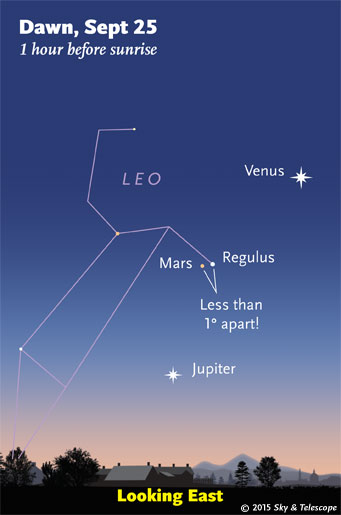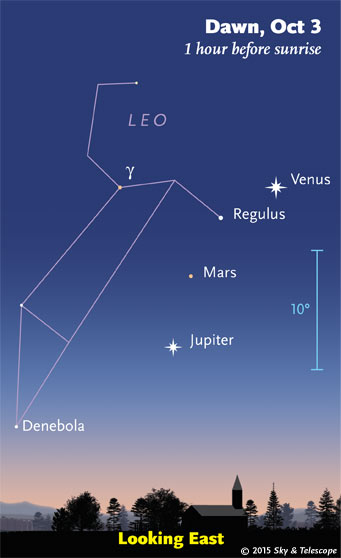This Week’s Sky at a Glance, Sept. 25 – Oct. 3

In early dawn, Mars passed Regulus on the morning of the 25th. They're still 1.1° apart on Saturday morning the 26th. After that they widen by about ½° per day.

By Saturday morning October 3rd, Mars moves nearly halfway from Regulus to Jupiter. The blue 10° scale is about the width of your fist at arm's length.
Friday, September 25
• Look far below the Moon this evening for 1st-magnitude Fomalhaut coming into view. Fomalhaut rises in late twilight. How soon can you spot it?
• Algol should be at minimum brightness for a couple hours centered on 6:09 p.m. EDT (according to Algol's recently updated schedule). It takes several additional hours to rebrighten.
Saturday, September 26
• With fall under way, Deneb is taking over from Vega as the zenith star at nightfall (for skywatchers at mid-northern latitudes). Look straight up after the end of twilight.
Sunday, September 27
• Total eclipse of the Moon! The eclipse happens for North America in the evening, South America later at night local time, and for Europe and much of Africa on the morning of Monday the 28th local time. Timetables and map. For more on the eclipse, including how to do crater timings, see the September Sky & Telescope, page 26.
It it cloudy? Are you on the other side of the world? We'll webcast the lunar eclipse, with commentary by S&T editors and lunar scientists. We start at 9 p.m. Sunday evening EDT (1:00 Sept. 28 UT/GMT).
On a night when the Moon gets eclipsed, it's always full.
Monday, September 28
• The Moon, a day past full, rises in the east in twilight. When the stars come out, look high above it for the Great Square of Pegasus.
Tuesday, September 29
• Vesta, the brightest asteroid, is at opposition. All week it remains magnitude 6.2, easy in binoculars (despite the moonlight) as it creeps through western Cetus. Use the finder charts in the September Sky & Telescope, pages 48–49.
Uranus, magnitude 5.7, is also nearby! Finder chart.
Wednesday, September 30
• As the stars come out, Cassiopeia is already higher in the northeast now than the sinking Big Dipper is in the northwest. The right side of Cassiopeia's broad W pattern tilts upward.
Thursday, October 1
• The waning gibbous Moon rises around 9 or 10 p.m., shining in the Hyades near Aldebaran. The Moon occults Aldebaran during dawn Friday morning for the West Coast, and in broad daylight Friday morning for telescope users in nearly all the rest of the U.S. and Canada. See the map and times in the September Sky & Telescope, page 49.
Friday, October 2
• After dark, look just above the northeast horizon — far below Cassiopeia — for bright Capella on the rise. How soon Capella rises, and how high you'll find it, depend on your latitude. The farther north you are, the sooner and higher.
Saturday, October 3
• By midnight or so, the waning Moon rises in the east-northeast. And to its right in the east, Orion is rising. The first bright star you hit looking right of the Moon is Betelgeuse: Orion's orange shoulder.
No comments:
Post a Comment